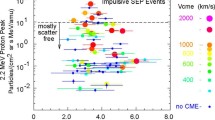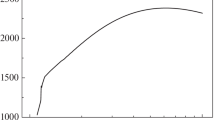Abstract
In a previous work (Paouris and Mavromichalaki in Solar Phys. 292, 30, 2017), we presented a total of 266 interplanetary coronal mass ejections (ICMEs) with as much information as possible. We developed a new empirical model for estimating the acceleration of these events in the interplanetary medium from this analysis. In this work, we present a new approach on the effective acceleration model (EAM) for predicting the arrival time of the shock that preceds a CME, using data of a total of 214 ICMEs. For the first time, the projection effects of the linear speed of CMEs are taken into account in this empirical model, which significantly improves the prediction of the arrival time of the shock. In particular, the mean value of the time difference between the observed time of the shock and the predicted time was equal to +3.03 hours with a mean absolute error (MAE) of 18.58 hours and a root mean squared error (RMSE) of 22.47 hours. After the improvement of this model, the mean value of the time difference is decreased to −0.28 hours with an MAE of 17.65 hours and an RMSE of 21.55 hours. This improved version was applied to a set of three recent Earth-directed CMEs reported in May, June, and July of 2017, and we compare our results with the values predicted by other related models.



Similar content being viewed by others
References
Dryer, M., Smart, D.F.: 1984, Adv. Space Res. 4, 291. DOI .
Falkenberg, T.V., Taktakishvili, A., Pulkkinen, A., Vennerstrom, S., Odstrcil, D., Brain, D., Delory, G., Mitchell, D.: 2011, Space Weather 9, S00E12. DOI .
Gopalswamy, N., Lara, A., Lepping, R.P., Kaiser, M.L., Berdichevsky, D., St. Cyr, O.C.: 2000, Geophys. Res. Lett. 27, 145. DOI .
Gopalswamy, N., Lara, A., Yashiro, S., Kaiser, M.L., Howard, R.A.: 2001, J. Geophys. Res. 106(29), 207. DOI .
Gopalswamy, N., Lara, A., Manoharan, P.K., Howard, R.A.: 2005, Adv. Space Res. 36, 2289. DOI .
Gopalswamy, N., Makela, P., Xie, H., Yashiro, S.: 2013, Space Weather 11, 661. DOI .
Gosling, J.T.: 1993, J. Geophys. Res. 98, 18937. DOI .
Hess, P., Zhang, J.: 2015, Astrophys. J. 812, 2. DOI .
Leblanc, Y., Dulk, G.A., Vourlidas, A., Bougeret, J.-L.: 2001, J. Geophys. Res. 106, 25301. DOI .
Liu, H.L., Qin, G.: 2015, J. Geophys. Res. 120(7), 5290. DOI .
Makela, P., Gopalswamy, N., Yashiro, S.: 2016, Space Weather 14, 5. DOI .
Mays, M.L., Taktakishvili, A., Pulkkinen, A., MacNeice, P.J., Rastatter, L., Odstrcil, D., et al.: 2015, Solar Phys. 290, 1775. DOI .
Millward, G., Biesecker, D., Pizzo, V., de Konig, C.A.: 2013, Space Weather 11, 57. DOI .
Odstrcil, D.: 2003, Adv. Space Res. 32, 497. DOI .
Odstrcil, D., Pizzo, V.J., Linker, J.A., Riley, P., Lionello, R., Mikic, Z., Luhmann, J.G.: 2004, J. Atmos. Solar-Terr. Phys. 66, 1311. DOI .
Paouris, E., Mavromichalaki, H.: 2017, Solar Phys. 292, 30. DOI .
Pulkkinen, A., Oates, T., Taktakishvili, A.: 2010, Solar Phys. 261, 115. DOI .
Sheeley, N.R., Walters, J.H., Wang, Y.M., Howard, R.A.: 1999, J. Geophys. Res. 104, A11. DOI .
Taktakishvili, A., Pulkkinen, A., MacNeice, P., Kuznetsova, M., Hesse, M., Odstrcil, D.: 2011, Space Weather 9, S06002. DOI .
Temmer, M., Reiss, M.A., Nikolic, L., Hofmeister, S.J., Veronig, A.M.: 2017, Astrophys. J. 835, 2. DOI .
Vrsnak, B., Sudar, D., Ruzdjak, D., Zic, T.: 2007, Astronomy and Astrophysics 469, 339. DOI .
Vrsnak, B., Zic, T., Vrbanec, D., Temmer, M., Rollett, T., Mostl, C., Veronig, A., Calogovic, J., Dumbovic, M., Lulic, S., Moon, Y.-J., Shanmugaraju, A.: 2013, Solar Phys. 285, 295. DOI .
Xie, H., Ofman, L., Lawrence, G.: 2004, J. Geophys. Res. 109, A03109. DOI .
Xie, H., Gopalswamy, N., Ofman, L., St. Cyr, O.C., Michalek, G., Lara, A., Yashiro, S.: 2006, Space Weather 4, 10. DOI .
Zhang, J., Richardson, I.G., Webb, D.F., Gopalswamy, N., Huttunen, E., et al.: 2007, J. Geophys. Res. 112, A10102. DOI .
Acknowledgements
We are grateful to the providers of the solar, interplanetary, and geomagnetic data used in this work. The coronal mass ejection data for the CMEs on 23 May, 28 June, and 14 July 2017 are taken from the CACTus CME list ( http://sidc.oma.be/cactus/catalog.php ). The prediction of the arrival time of the shocks for the Earth-directed CMEs used in Section 4 are taken from the CME Scoreboard ( https://kauai.ccmc.gsfc.nasa.gov/CMEscoreboard/ ). Thanks are also due to the anonymous referee for the comments that improved this paper.
Author information
Authors and Affiliations
Corresponding author
Ethics declarations
Conflict of interest
The authors declare that they have no conflicts of interest.
Rights and permissions
About this article
Cite this article
Paouris, E., Mavromichalaki, H. Effective Acceleration Model for the Arrival Time of Interplanetary Shocks driven by Coronal Mass Ejections. Sol Phys 292, 180 (2017). https://doi.org/10.1007/s11207-017-1212-2
Received:
Accepted:
Published:
DOI: https://doi.org/10.1007/s11207-017-1212-2




